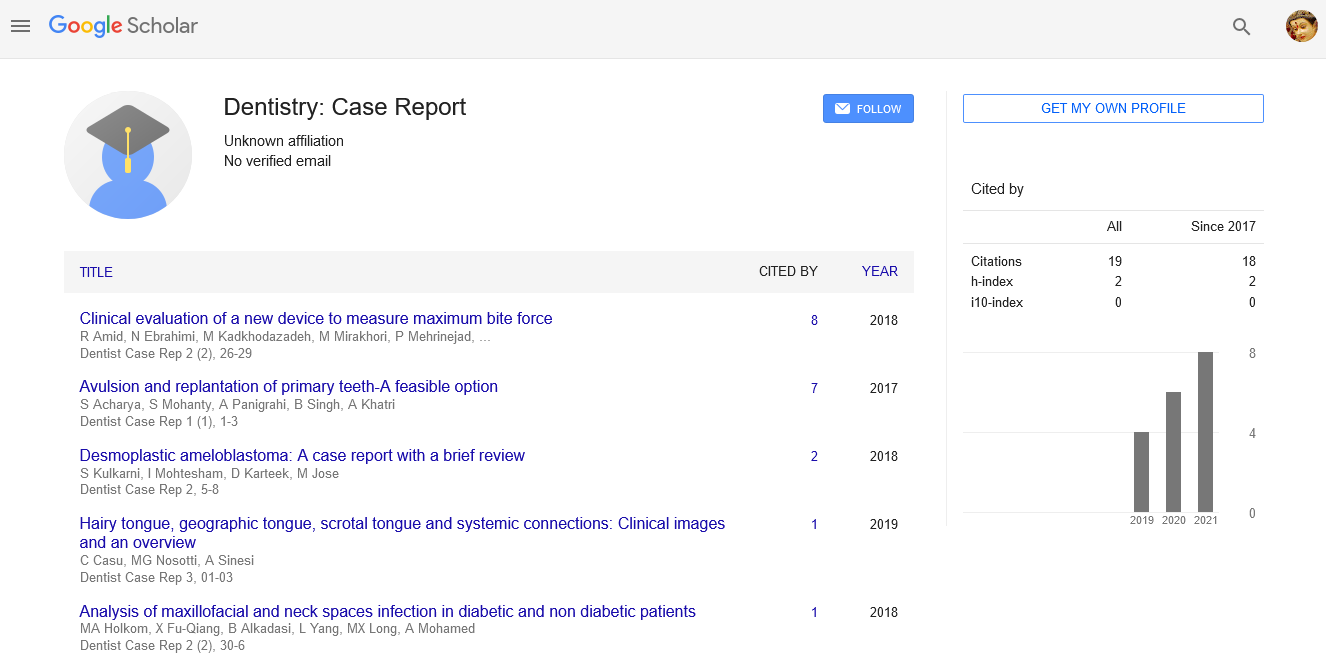Genes in oral and dental diseases
Received: 11-Jan-2022, Manuscript No. puldcr-22-4652; Editor assigned: 13-Jan-2022, Pre QC No. puldcr-22-4652; Accepted Date: Jan 27, 2022; Reviewed: 20-Jan-2022 QC No. puldcr-22-4652; Revised: 24-Jan-2022, Manuscript No. puldcr-22-4652; Published: 27-Jan-2022, DOI: 10.37532. puldcr.22.6.1.1
This open-access article is distributed under the terms of the Creative Commons Attribution Non-Commercial License (CC BY-NC) (http://creativecommons.org/licenses/by-nc/4.0/), which permits reuse, distribution and reproduction of the article, provided that the original work is properly cited and the reuse is restricted to noncommercial purposes. For commercial reuse, contact reprints@pulsus.com
Abstract
The range of disorders caused by genetic changes in the oral cavity includes anything from tooth development problems to pre-cancerous and malignant tumors. In recent years, tremendous progress has been achieved in the field of tumor molecular analysis. This article examines genetic abnormalities spanning from the formation of orofacial structures to malignancies in the head and neck area, with molecular genetic testing emerging as a diagnostic, prognostic, and therapeutic strategy. Genes' functional regulatory aspects in relation to oro-facial structures are explored individually, i.e., tooth genesis, tooth agenesis (non-syndromic, syndromic), tooth structural modifications, syndromic oro-facial deformities, bone illnesses, skin diseases (genodermatoses), and malignant tumors. Various genes involved in the formation of orofacial structures, particularly teeth, are described in this literature.
Introduction
The genetic foundation of tooth development problems (agenesis, hypodontia), tooth structural defects such as Amylogenesis Imperfect (AI), Dentin Genesis Imperfect (DI), and oro-facial structural modifications (different syndromes) is discussed. Genetic illnesses are significantly more frequent than most people realize, and the genetic diseases that doctors see are just the top of the iceberg. Genetic illnesses are projected to occur 670 times per 1000 people throughout their lifetime. Humans contain only 30,000 genes, and the explosion of information in this subject in recent years has resulted in the transformation of genetics (the study of single or few genes and their phenotypic consequences) into genomics (the study of all genes and their effects) (study of all the genes in the genome and their interactions). New approaches to explain the etiology and pathophysiology of many human disease processes, including oredental illnesses, have emerged as a result of advances in genetics and molecular biology. Technological advancements in molecular biology have enabled methods to investigate gene structural changes linked to certain diseases. Some of the technical developments in molecular biology include blotting methods, PCR, in-situ hybridization, and cDNA microarrays. In recent years, cytogenetics and molecular biology tools have changed genetics. The reciprocal connection between the ectoderm and the underlying mesenchyme is exemplified by tooth formation. Proliferation, condensation, adhesion, migration, differentiation, and secretion are all consecutive cell actions that culminate to the creation of a functioning tooth organ. Recent developments in molecular aspects of ontogenesis suggest that tooth formation is tightly regulated by genetics. The position, quantity, and form of different types of teeth are determined by more than 300 genes. [1] Several abnormalities of the teeth are caused by mutations in genes encoding transcription factors and signaling molecules involved in ontogenesis. Home box genes are the most widely investigated genes in tooth formation. A Home Box (HOX) is a DNA sequence of around 180 base pairs that is located inside genes involved in the control of animal, fungal, and plant development (morphogenesis). Home box genes are genes that have a home box and belong to the home box gene family. Home box genes code for transcription factors that turn on a series of other genes. HOX genes are a group of home box genes that act in patterning the body axis, determining where body segments grow in a growing baby and establishing the identity of a certain body area. Any of these genes can be mutated, resulting in the creation of additional, usually nonfunctional body parts. As a result, mutations in home box genes might result in phenotypic alterations that are plainly observable. PAX-9 is one of nine transcription factors in the PAX family, each of which has a DNA-binding domain known as the paired domain. They are essential organogenesis regulators that can cause cellular differentiation. PAX-9 is found in the neural crest-derived mesenchyme, which plays a role in craniofacial and dental development. Mutations in the PAX-9 gene, which is located on 14q12-q13, can cause non-syndromic tooth agenesis. PAX-9-/- mice have a cleft of the secondary palate, as well as various skeletal abnormalities, a loss of thymus and parathyroid glands, and no teeth. Prior to the first morphological expression of odontogenesis, PAX -9 is expressed in the dental mesenchyme. Tooth development in homozygous PAX -deficient mouse embryos is stopped at the bud stage, suggesting that PAX -9 is essential for tooth development to continue past this point. PAX -9 is necessary for mesenchymal expression of Bmp-4, MSX-1, and Lef-1, suggesting that its role is critical for establishing the tissue's inductive capability.





